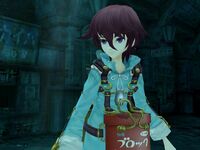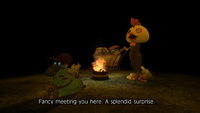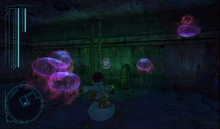Fragile Dreams: Farewell Ruins of the Moon (フラジール ~さよなら月の廃墟~, Fragile: Sayonara Tsuki no Haikyo) is a role-playing post-apocalyptic adventure game for the Nintendo Wii. The game was developed by Namco Bandai Games and Tri-Crescendo and released by Namco in Japan on January 22, 2009 before being released in North America by Xseed games[1] and in Europe by Rising Star Games.[2]
The game follows the experiences of a 15-year old boy named Seto who sets out into the world following the death of his caretaker. After a mysterious apocalypse mankind is left near extinct, and with a hopeful step Seto braves the world in search of other survivors like himself.
Plot[]
Fragile Dreams is set in the near-future, where an apocalypse has left humanity dwindling and cities in ruin. The game drops the player in the worn shoes of Seto, a young boy. In the game's opening, Seto narrates how his "grandfather," an old man that he lived with, died at the end of the summer. He buries his grandfather, and from that moment on he is truly alone. Seto decided to set out in search for other survivors in the ruins of Tokyo, marking the beginning of the game's events.
Setting[]
The game is set in abandoned areas of Tokyo and the surrounding land. Many of the locations the player ventures into are dark, with little to no lighting, and in a decrepit state, owing to the disappearance of mankind. Much of the settings are faithful recreations of real-world locations, especially the tunnels and utility systems underneath Tokyo. Aside from desolate ruins, Seto also visits more colorful locales and the game emphasizes the beauty of overgrowth and the natural sky after the disappearance of humans.
Characters[]

Seto, the main character

My scans indicate that spoilers are ahead.
Please be careful.
- Seto: A fifteen-year-old boy who has little experience of the world outside his home. After the old man he lives with passes away, Seto travels alone searching for survivors like himself. Following clues from a letter left by the old man, Seto heads east towards a shining red tower. In the English version, he is voiced by Johnny Yong Bosch. In the Japanese version, he is voiced by Houko Kuwashima.
- Ren: A silver-haired girl whom Seto first encounters sitting on a crumbling subway entrance, singing beneath the moonlight. Whilst walking through ruins, Ren playfully draws colorful doodles, looks for abandoned treasures, plays with stray cats, and lives a carefree life. In the English version, she is voiced by Danielle Judovits. In the Japanese version, she is voiced by Miku Yoshikawa.
- Personal Frame (P.F.): A portable computer that Seto carries on his back. Having been abandoned for a long time, she was happy when Seto rescues her and helps guide him through the ruins. She loves having conversations more than anything else, and dutifully serves Seto to her fullest. The English voice is provided by Nicole Karrer. in the Japanese audio, she is voiced by Umeka Shōji.
- Sai: The ghost of a young woman, bored of wandering the abandoned hotel she died in. She comes along with Seto out of curiosity, but later shows that she has a connection to what brought about humanity's demise. In the English version, she is voiced by Karen Strassman. In the Japanese version, she is voiced by Ryo Hirohashi.
- Crow: A mischievous and straightforward boy. Though he remembers nothing of his past, he refuses to despair and remains cheerful. In order to find his birthplace, he relies on only a single photo. Though he and Seto get off to a rocky start, they soon become friends. He is voiced by Steve Staley in the English version and by Mie Sonozaki in the Japanese version.
- Chiyo: A bratty little girl Seto encounters in a decrepit hotel. She hovers, ghost-like, barring Seto's progress and requesting seemingly impossible tasks before trusting him. She is voiced by Laura Bailey in the English version and Chiwa Saitō in the Japanese version.

Seto and PF at a bonfire with the Merchant.
- The Merchant: A mysterious man who trades in various goods. Always merry, he collects lots of sparkling things. He is most notable for the large chicken head he wears on his head, where only his red eyes are seen through the mouth. He is voiced by Dave Wittenberg in the English version and Tomohisa Asō in the Japanese version.
- Shin: A researcher from days long past. Seto hears this man's menacing voice ordering Ren to return to him. Just what is his connection to the silver-haired girl, and how does it relate to the disaster that wiped out humanity? He is voiced by Troy Baker in the English version and Toshio Furukawa in the Japanese version.[3]
Gameplay[]

Seto fighting some enemies in an underground tunnel
- Main article: Fragile Dreams Gameplay
The gameplay of the game is, in a sense, a hack-and-slash adventure game, where the player has to journey from area to area defeating enemies that appear and fulfilling objectives. Many elements of the game take on a role-playing aspect, such as experience points, leveling up, weapon types, and collectible items. In addition to weapons, Seto is armed with a flashlight to reveal the way and interact with the environment.
Items are scattered across the game's world, highlighted by the glow of fireflies flying around it. Some items serve a specific, immediate purpose, but the majority of the items that can be found are Memory Items, objects that hold the memories of people and help clarify the game's plot and the disaster that occurred in the past. Additionally, most items are picked up as Mystery Items and must be brought to a Bonfire, the game's save point, before they can be identified.
The enemies are a menage of animals, ghosts, demons, and robots. Their presence is indicated when ominous music begins to play in the background, however, enemies only have a limited range and will not attack Seto outside of their areas. In addition to common enemies, boss fights also occur along Seto's journey. Enemies also present a chance to obtain items that can be used or sold to the Item Merchant for money to buy other items. However, every weapon has a chance of breaking while being used, a hazard that can quickly turn the tides of battle.
Fragile Dreams also makes considerable use of the Wii Remote speaker, using it to indicate the location of enemies, project environmental sounds, and provide directional clues.
Development[]
Fragile Dreams was developed by the team at Namco Bandai Games that was responsible for the Playstations 2 titles Venus & Braves and Seven. Director and producer Kentarō Kawashima did not originally create the game for the Wii, as he developed the concept in 2003 before the Wii's release.[4][5] Kawashima wrote the main plot for Fragile Dreams, with the rest of the events being handled by sub-scenario writer Gingitsune.[6] Upon revelation of the Wii Remote, the console became the natural choice for the flashlight control Kawashima intended. In addition to the main story, Fragile Dreams contains 22 short stories in the form of Memory Items, which were written by different writers and fans. [7]
Composer Riei Saito carefully crafted the sounds of Fragile Dreams to complement the atmosphere of the game and the dilapidated yet captivating environments. The game's opening and ending themes, Hikari (光, light) and Tsuki no Nukumori (月のぬくもり the moon's warmth) respectively, were performed by Aoi Teshima. Xseed Games also released the North American version with a dual-language option (containing both dubs in Japanese and English), so as not to interfere with the original game designer's vision.[8] Promotion for the game included two trailers that are available for viewing after completing the game. Pre-order bonuses were also given for both Japan and North American releases, and included a CD of select game music
Reception[]
In the first week of its Japan release Fragile Dreams sold 26,055 copies, making it the 2nd best-selling game of the week.[9] The game currently has a score of 67/100 (based on 41 reviews) on review aggregate site Metacritic.[10] Japanese gaming magazine Famitsu awarded the game a score of 31 out of 40.[11]
Praise was given to the game's melancholic atmosphere, detailed environments, surreal monster design, and music. Michael Lafferty from Gamezone portrays the game in a more positive light, stating "While the story is intriguing, what really brings this game home are the beautiful graphics and amazing audio. The emotional elements – like a haunting loneliness that pervades the world, the despair resonating in the voices of the characters – are clearly in place and Fragile Dreams' development team, Tri-Crescendo, has found the right mix for a game that is truly a wonderful experience."[12] Dylan Snyder of Gamer Limit agreed, awarding the game a score of 9 out of 10.[13] Bitmob writer Jasmine Rea called the game an "experience rather than a game" and likened its emotional impact to that of Isao Takahata's adaptation of Akiyuki Nosaka's novel Grave of the Fireflies.[14]
Criticism largely came from the gameplay of Fragile Dreams, which, in many reviewers' perspective, was not balanced with the game's outstanding style. Matt Casamassina from IGN gave the game a score of 6.7 out of 10, stating "Fragile Dreams is a great example of a spectacular concept whose execution could have used a little more thought and time."[15] One common complaint of the game revolves around the final acts of the game, which involves sparser storyline per gameplay ratio, and involves walking through linear endless tunnels, as opposed to the more open environments seen in the game's beginning acts. Many players found these end-game sections to be on the tedious side. The game's storyline has been contested due to how vague it can be at times. The game's developers mentioned they had thoughts of making a sequel, which may explain why the game's story may have been somewhat vague for a possible sequel to answer questions.
Regardless, Fragile Dreams is considered by many to be a cult classic of sorts.
References[]
- ↑ IGN Game Information
- ↑ Ishaan (June 28, 2009). "Nintendo Power Sheds Light On Fragile’s Exploration". Siliconera.com. Retrieved 2009-06-28.
- ↑ IGN: Fragile Update
- ↑ Riley, Adam (19 May 2009). "Interview: Namco Bandai Talks Fragile (Wii), Sequel Planned?". Cubed3.com. Archived from the original on 6 March 2011. Retrieved 11 June 2009.
- ↑ Namco Bandai Games Inc.; Tri-Crescendo Co., Ltd.. Fragile Dreams: Farewell Ruins of the Moon. (Xseed JKS, Inc.). Scene: staff credits. (16 March 2010)
- ↑ Gingitsune (14 March 2008). "Fragile通信 第8号". Namco Bandai Games Inc.. Retrieved 6 March 2011.
- ↑ Parkin, Simon. "Fragile Dreams Review at Eurogamer". Eurogamer. Retrieved 2010-07-25.
- ↑ IGN: Pre-E3 2009: Fragile Coming to America!
- ↑ Tanaka, John (January 30, 2009). "Mario Tennis Tops Japanese Charts". IGN.com. Retrieved 2009-02-02.
- ↑ "Fragile Dreams reviews at Metacritic". Metacritic. Retrieved 2010-07-25.
- ↑ jahiggin (January 14, 2009). "Famitsu: Review Scores". PureNintendo.com. Retrieved 2009-02-02.
- ↑ http://wii.gamezone.com/gzreviews/p38342_02.htm
- ↑ Snyder, Dylan. "Fragile Dreams review on Gamer Limit". Gamer Limit. Retrieved 2010-07-25.
- ↑ http://www.bitmob.com/articles/in-defense-of-fragile-dreams-farewell-ruins-of-the-moon
- ↑ Casamassina, Matt. "Fragile Dreams at IGN". IGN. Retrieved 2010-07-25.
External links[]
- http://fragile.namco-ch.net/ Official website (Japanese)
- http://www.fragiledreamswii.com/ Official website
- Fragile Dreams: Farewell Ruins of the Moon Wikipedia article


